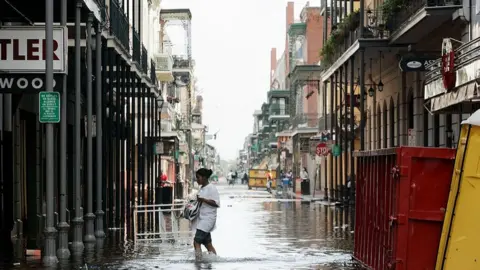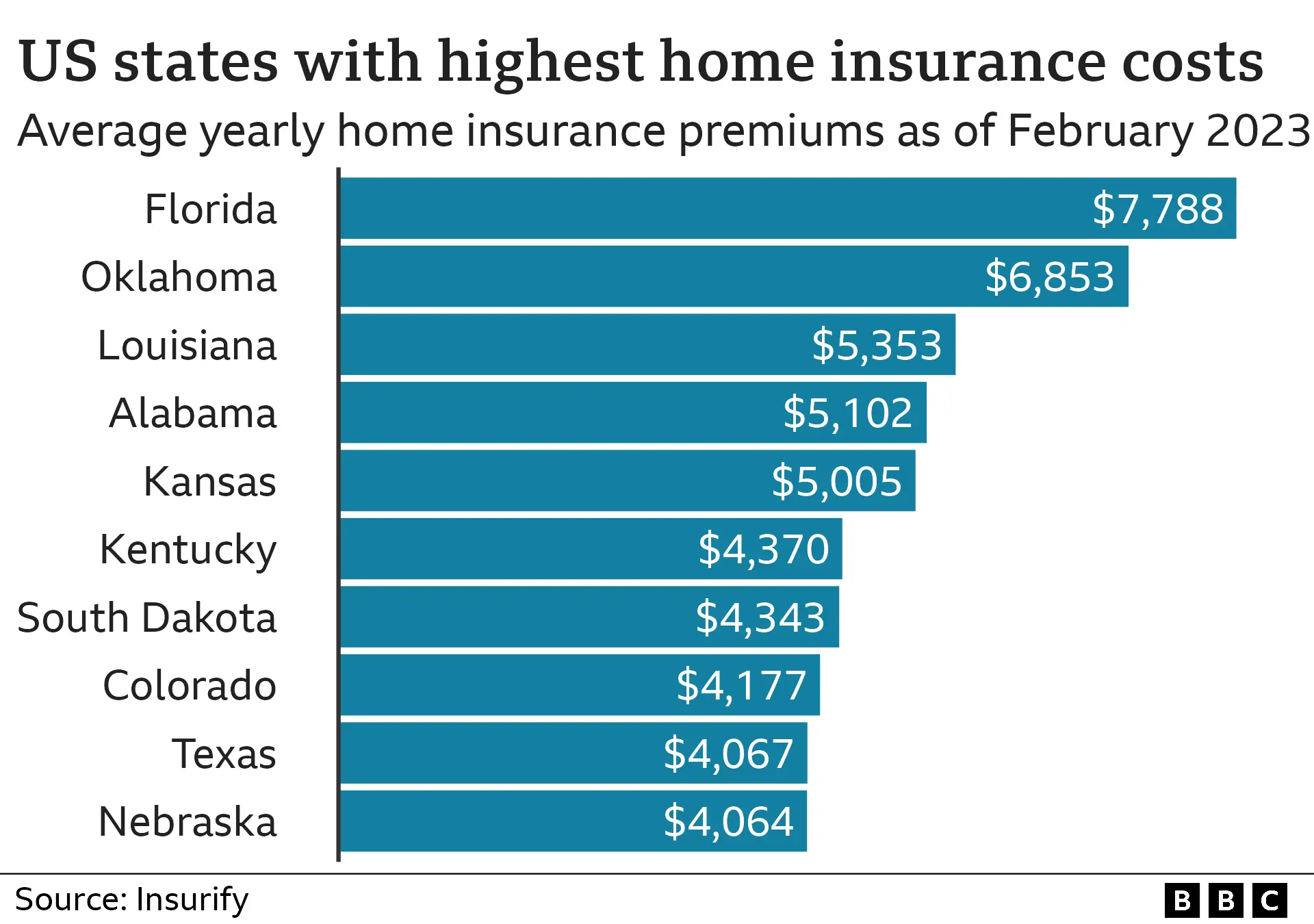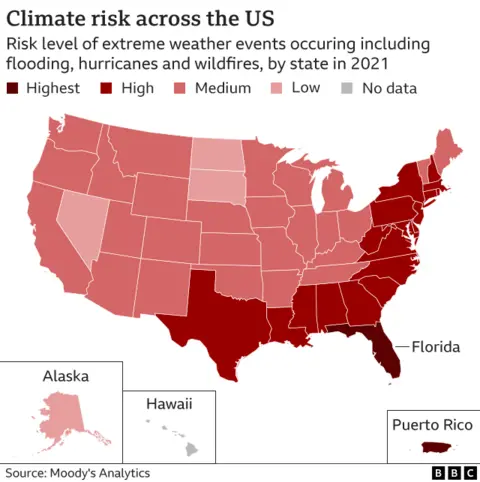'Who will buy my house if they can't get insurance'
 Getty Images
Getty ImagesAs extreme weather events multiply, home insurance providers in the US are rapidly raising rates - or quitting the business altogether - forcing many into severe financial distress.
Gretchen Bradford decided this year not to pay for home insurance.
The 59-year-old has lived her whole life in New Orleans, which sits on Louisiana's Gulf Coast in a zone climate experts call Hurricane Alley for the devastating storms - including Hurricane Katrina in 2005 - that routinely crash against its shores.
She lives in the home her parents purchased in 1958, a prized possession which, after each hurricane, has become increasingly expensive to protect with home insurance.
In 2021, she was paying $3,035 (£2,386) annually. After her insurer stopped writing new policies in her neighbourhood, in 2022, the quote she received from the state-backed plan was more than triple that amount - $9,876 - a sum she could not afford.
"To pay insurance would be taking away from food on my table, right now," says Ms Bradford, who relies on disability insurance for her income.
 Gretchen Bradford
Gretchen Bradford"I can't grow money out of trees. I don't have it. So, I don't know what else to do."
Ms Bradford is not alone in her plight.
Across the country, home insurance prices are spiking, as companies raise rates and limit coverage, responding in part to the fallout from more frequent extreme weather, which scientists attribute to climate change.
Dozens of smaller insurers have gone out of business, unable to withstand the shock of multiple billion-dollar disasters.
In states heavy hit by storms, wildfires and flooding, such as California, Florida and Louisiana, some big providers have stopped writing new policies altogether.
Companies say the upheaval reflects the huge number of claims in recent years, rising costs of repairs underlined by inflation, and growing risks in the years ahead, as climate-change induced catastrophes multiply.
Spiking rates
Across the country, premiums are expected to rise 9% this year to an average of $1,784 nationally, after jumping 7% in 2022, according to Insurify, an insurance comparison site.
The increases are far larger in the most at-risk places, such as Louisiana, where Insurify estimates that home insurance costs average more than $5,000 annually, up more than 65% since 2021.
The crisis has forced a dramatic expansion in state-backed plans, which are funded by taxpayers and are often some of the highest cost options.
The situation has left many in the US - where, as in the UK, home insurance is typically required if you have a mortgage - facing desperate choices.
Louisiana resident Teddy Mars says he withdrew $12,000 from retirement savings last month to help cover a jump in his insurance costs.
The 44-year-old operations consultant had to find a new provider this year, after his insurance company left the state.
He eventually cobbled together coverage with help from Louisiana's state-backed programme. But the new set-up more than doubled his monthly housing costs, including his mortgage, from about $882 to more than $2,100 - blowing a sudden hole in his family's budget.

The family has cut back on food and clothing, but with a teenager in the house, he says it is still spending more than he and his wife, who works in education, bring in.
"It's not sustainable," Mr Mars says. The Louisiana native says he has considered selling, but fears the impact of the insurance crisis: "Who's going to want to buy it if they can't insure it?"
Property risk
As insurance availability shrinks and premiums rise, the shock is expected to force a reckoning in the property market in the US, reducing demand for homes in the areas at most risk from wildfires, heat and storms - many of the same places that have experienced recent rapid growth, as movers seek out sun, jobs and more affordable housing.
"There's never been a time, in at least the US context, when you would say something's not insurable and we're getting to that point now," says Jeremy Porter, head of climate implications research for First Street Foundation, a non-profit that studies climate risks.
"We're not seeing it play out fully right now, but … people are starting to understand this risk and they're starting to take this into account."
The impact, as some areas grow abruptly less desirable, is expected to be felt unevenly over the next decades, depending on when and where disaster strikes.
In a high-risk city like New Orleans, homes - traditionally the source of most Americans' wealth - could appreciate 20% to 30% slower than expected, according to Climate Alpha, a start-up that works with property firms to analyse climate risk.
"It's all non-linear, which is a fancy way of saying it's going to come at you faster and harder and more randomly than you thought," chief executive Parag Khanna says.
Leaving Louisiana
In Louisiana, property values have already risen more slowly than the national average, in part as high monthly insurance costs eat into buyers' budgets.
Between 2020 and 2022, the state's population also shrank at one of the fastest rates in the country, as the back-to-back storms and the spike in costs drove people away.
Tyler Coats, who bought a home in New Orleans in 2011, left the city for Arkansas in early 2020, fed up with the risks of power outages and flooding.
 Tyler Coats
Tyler CoatsThe 36-year-old small business owner had settled in the Big Easy after university, enjoying the night life and inspired to help the city rebuild after Hurricane Katrina.
Buying made more sense for him financially than renting. But from the beginning, he says, his monthly insurance payment was more than his mortgage.
After marrying and having a baby, he says the worries stopped being worth it.
"Every year, you're dealing with this hurricane season, where you don't know if you're going to lose everything you've invested," he says. "I wasn't getting that feeling of stability that was the whole reason I bought the house in the first place."
Mr Coats has little regret about leaving. He now pays less for insurance on a much bigger property.
"I could see the writing on the wall - I believe in climate change," he says. "Yes, I miss New Orleans …but I want to provide the most stability possible and that's just not something that was on the table."
For homeowners unwilling or unable to move, however, it is not clear how relief will arrive.
Louisiana lawmakers recently approved roughly $45m in incentives to try to tempt more insurance companies back to the state and spread the risks, an approach that helped to stabilize prices after the devastation of Hurricane Katrina in 2005.
It may not be enough this time.
As concerns about climate risks spread globally, it has raised the costs that insurance providers face for their own insurance policies, which are meant to protect them in the event of big, unexpected losses.
"Other catastrophes around the globe, Germany, Australia, Canada, and California, etc., are impacting the availability of reinsurance," says Jim Donelon, the commissioner of insurance for Louisiana. "We are in a crisis. No question about it."

As it stands, the pain is expected to disproportionately affect lower income households, like Ms Bradford.
She says her home, in Pontchartrain Park, a once-segregated black neighbourhood now listed on the National Register of Historic Places, is one she will "never" sell.
But her resolve to stay is mixed with pride and nervousness.
"This is my first time feeling vulnerable," she says. "And I guarantee I'm not the only one."
Mr Porter, of the First Street Foundation, says companies need to work with lawmakers to figure out how to shield homeowners from the shocks of sudden spikes in their insurance premiums, while the government invests in systems, like pumps, to increase resiliency.
But he warns that the US cannot - and should not - provide so much help that people ignore the message the insurance increases are sending.
He points to the example of the national flood insurance programme that the US started in 1968, which has been criticised for encouraging development in risky areas by shielding builders and buyers from the true risks.
It finally overhauled its rates, after suffering huge losses and needing $16bn in debts to be cancelled by Congress. The changes led to big spikes for many homeowners last year, which ten states, including Louisiana, are now challenging in a lawsuit.
"It's a hard discussion to have and I don't think we're very far along," says Mr Porter. But "if what we're going to do ... is subsidise insurance ... sooner or later the bill is going to come due."
